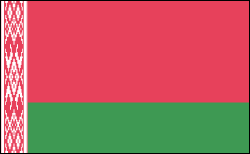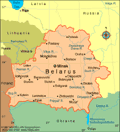Belarus | Facts & Information

- Belarus Profile
- History
- News and Current Events
Infoplease has everything you need to know about Belarus. Check out our country profile, full of essential information about Belarus's geography, history, government, economy, population, culture, religion and languages. If that's not enough, click over to our collection of world maps and flags.
Facts & Figures
-
Republic of Belarus
President: Alyaksandr Lukashenka (since 1994)
Prime Minister: Andrey Kabyakow (since 2014)
Total area: 80,154 sq mi (207,600 sq km)
Population (2014 est.): 9,608,058 (growth rate: -0.19%); birth rate: 10.86/1000; infant mortality rate: 3.64/1000; life expectancy: 72.15
Capital and largest city (2011 est.): Mensk (Minsk), 1.861 million
Other large cities: Gomel, 502,200; Mogilyov, 374,000; Vitebsk, 355,800; Grodno, 314,100; Brest, 306,300; Bobruysk, 228,100
Monetary unit: Belorussian ruble
National Name: Respublika Byelarus'
Languages: Belarusian (official) 23.4%, Russian (official) 70.2%, other 3.1% (includes small Polish- and Ukrainian-speaking minorities), unspecified 3.3% (2009 est.)
Ethnicity/race: Belarusian 83.7%, Russian 8.3%, Polish 3.1%, Ukrainian 1.7%, other 2.4%, unspecified 0.9% (2009 est.)
Religion: Eastern Orthodox 80%, other (including Roman Catholic, Protestant, Jewish, and Muslim) 20% (1997 est.)
National Holiday: Independence Day, July 3
Literacy rate: 99.6% (2009 est.)
Economic summary: GDP/PPP (2013 est.): $69.24 billion; per capita $16,100. Real growth rate: 2.1%. Inflation: 19%. Unemployment: 1% (2009 est.) officially registered unemployed; large number of underemployed workers. Arable land: 26.63%. Agriculture: grain, potatoes, vegetables, sugar beets, flax; beef, milk. Labor force: 5 million (2009); agriculture 9.4%, industry 45.9%, services 44.7% (2003 est.). Industries: metal-cutting machine tools, tractors, trucks, earthmovers, motorcycles, televisions, chemical fibers, fertilizer, textiles, radios, refrigerators. Natural resources: forests, peat deposits, small quantities of oil and natural gas, granite, dolomitic limestone, marl, chalk, sand, gravel, clay. Exports: $45.17 billion (2013 est.): machinery and equipment, mineral products, chemicals, metals, textiles, foodstuffs. Imports: $45.17 billion (2012 est.): mineral products, machinery and equipment, chemicals, foodstuffs, metals. Major trading partners: Russia, Netherlands, Germany, Ukraine, China, Latvia (2012).
Communications: Telephones: main lines in use: 4.407 million (2012); mobile cellular: 10.675 (2012). Broadcast media: 4 state-controlled national TV channels; Polish and Russian TV broadcasts are available in some areas; state-run Belarusian Radio operates 3 national networks and an external service; Russian and Polish radio broadcasts are available (2007). Internet hosts: 295,217 (2012). Internet users: 2.643 million (2009).
Transportation: Railways: total: 5,537 km (2008). Highways: total: 86,392 km (2010). Waterways: 2,500 km (major rivers are the west-flowing Western Dvina and Neman rivers and the south-flowing Dnepr River and its tributaries, the Berezina, Sozh, and Pripyat rivers) (2011). Ports and harbors: Mazyr. Airports: 65 (2013).
Transportation: Railways: total: 5,512 km (2004). Highways: total: 79,990 km; paved: 69,351 km; unpaved: 10,639 km (2004). Waterways: 2,500 km (use limited by location on perimeter of country and by shallowness) (2003). Ports and harbors: Mazyr. Airports: 101 (2005).
International disputes: boundary demarcated with Latvia and Lithuania; as a member state that forms part of the EU's external border, Poland has implemented strict Schengen border rules to restrict illegal immigration and trade along its border with Belarus









